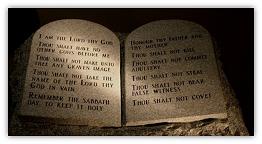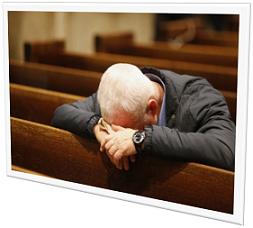How Do I Know Sin?
How Do I Know Sin?
Law and Gospel⤒🔗
We argued and emphasized that the essence of sin is revealed mostly at Golgotha, as the heart of the gospel. This is, however, not in contradiction with Lord’s Day 2 of the Heidelberg Catechism, where we confess that we know our sin and misery from God’s law (see also LD 44). Doesn’t it say in Romans 3:20 that through the law comes knowledge of sin? The law reveals sin, points out sin, and is even the catalyst of sin. Indeed, the potential of sin realizes itself precisely in regard to the law.
Following the example of Luther – but also Calvin knows this thought – God’s law is portrayed as a heavy-handed pedagogue. The law needs to be preached strictly (see HC Q. 115). It is a lifelong process to know more and more our sinful nature. In the same way we are driven ever more to Christ, to glory in his justice alone.
 The law stands in service to the gospel, similar to how a needle stands in service to the thread. God beats down on us by means of the law in order to raise us again through the gospel. He reveals to us our sin (more and more), to make us experience the riches of forgiveness (more and more). Calvin taught very clearly that the entire life of a believer consists of a life of penitence, and that not only the coming to life of the new man, but also the dying of the old man is possible only through our connection with Christ. Knowing your misery is therefore knowing faith. When the Lord shows us our brokenness in the depths, he holds on to us in Christ.
The law stands in service to the gospel, similar to how a needle stands in service to the thread. God beats down on us by means of the law in order to raise us again through the gospel. He reveals to us our sin (more and more), to make us experience the riches of forgiveness (more and more). Calvin taught very clearly that the entire life of a believer consists of a life of penitence, and that not only the coming to life of the new man, but also the dying of the old man is possible only through our connection with Christ. Knowing your misery is therefore knowing faith. When the Lord shows us our brokenness in the depths, he holds on to us in Christ.
There is the duality of law and gospel. We hold firm to the theological (not chronological), the thematic (not schematic) sequence of law first, followed by gospel. Do not create a diametrical contrast between law and gospel. Luther, who put such a heavy emphasis on the discovering power of the law – as a hammer that breaks the rock in pieces (Jer. 23:29), as a smoking Mount Sinai that wants to lead to wholesome despair – knows also of the evangelical knowledge of our misery, the revelation of sin at the foot of the cross. That is why he writes in his commentary on Galatians 1:4 (i.e., the phrase “who gave himself for our sins”):
“This sentence also defines our sins as great, so great in fact that the whole world could not make amends for a single sin. The greatness of the ransom, Christ, the Son of God, indicates this. The vicious character of sin is brought out by the words ‘who gave himself for our sins.’ So vicious is sin that only the sacrifice of Christ could atone for sin. When we reflect that the one little word ‘sin’ embraces the whole kingdom of Satan, and that it includes everything that is horrible, we have reason to tremble.”
Mirror and Window←⤒🔗
Knowledge of sin does not come through hearing some decrees from a law that has been abstracted from the living God and his act of salvation. It is for that reason that the Heidelberg Catechism makes clear that Christ is our teacher, teaching us our awareness of misery from God’s law. Christ teaches us that love is the fulfillment of the law. On Golgotha Christ practiced the law to its fullest extent, to the ultimate consequence. In his active obedience we see the actual focus of the law: love until the very end. But also in his passive obedience we are shown the full and complete revelation that the Lord is a holy God, and a wrathful Avenger of all injustice. The mirror of the law can only be a true discovery mirror when it is at the same time a window – a window to God and Christ. When they truly come into my life, then I learn to know myself. That is comfort in despair, and that is how it remains in the life of faith. The knowledge of our sin and misery is never superseded, but rather it is continuously intensified through the knowledge of grace.
The Holy Spirit makes us alive with Christ, and that runs counter to our repentance. When Christian, in Bunyan’s Pilgrim’s Progress, sees his sons disappearing into the open grave of Christ, he is not only freed and inexpressibly joyful, but at the same time his heart breaks into a thousand pieces. The knowledge of our misery is deepest in the light of the cross. But we will never taste utter forlornness of sin until we have reached the bottom. Only the Mediator has done so. Together with all the holy ones the individual believer knows misery only in part. But he knows enough to know himself a sinner before God, and as a person lost by himself learning to plead for his grace.
He knows enough – on account of the deeply embedded character, the far-reaching range of sin – to bring about a lasting brokenness in the life of a Christian. He or she remains in the experience of faith “simul iustus ac peccator,” at the same time righteous and sinner.
A Precise Positioning←⤒🔗
I had already written the paragraphs above when I learned of the book Wet en Evangelie (Law and Gospel) by W.H. Velema. In this book he offers us a further positioning of law and gospel in light of three aspects: the theocentric, redemptive-historical, and existential-soteriological perspective. In the theocentric perspective the focus is on how the relationship with God is affected. Here we need to maintain the sequence “first the law, then the gospel.”  First there is the law, instituted by God. Because of the fall into sin man becomes guilty before this law. The gospel follows the disobedience to the law, and touches man in his guilt before God. In the gospel God reacts to the misery that man has caused for himself. With the gospel God seeks man who transgressed the law. The law therefore provides the address of the gospel.
First there is the law, instituted by God. Because of the fall into sin man becomes guilty before this law. The gospel follows the disobedience to the law, and touches man in his guilt before God. In the gospel God reacts to the misery that man has caused for himself. With the gospel God seeks man who transgressed the law. The law therefore provides the address of the gospel.
However, from a redemptive-historical perspective there is a reverse order: first gospel, then law. The fact is that after the fall, the traces that are still left in men’s consciences according to general revelation can only have an effect of estrangement and condemnation. The Lord then presents his law again in the context of the gospel. The God who delivered Israel from slavery in Egypt proclaims now the Ten Commandments from Mount Sinai. In this way God the Redeemer reveals his law anew, such that man would realize his lost condition before the face of him who had shown so much grace. In this manner – and in line with texts such as Romans 5:20, 7:7, 9, 10, Galatians 3:19 – there is room for the continuous elenctic (discovery) function of the law in the life of faith. The texts mentioned may not be explained in a purely redemptive-historical manner in the sense that this function would no longer be applicable after Christ’s coming.
In the experience of the believer, in the knowledge one has about himself before the face of God (existentially) and in the manner in which the sinner will share in Christ’s salvation (soteriological), we can speak of an interlocking of law and gospel. Therefore, not “one after the other” but “beside each other.” When Paul writes, “Through the law comes knowledge of sin” (Rom. 3:20), he is saying this in the context of the gospel. There is no room for schematics here, but rather a groundswell where again and again repentance and guilt, trespass and forgiveness come to the fore.
In the developments after Calvin we see repeated instances where his clear insight – that true repentance comes to fruition only through our sharing in Christ – is obscured. People can be faced with an “initial fear,” a crisis of conscience before they actually know who God is and before they are brought to Christ. But such a time of fear and anxiety may certainly not be prescribed as being an indispensable gate before they come into the house of faith. A Christian repentance may not be reduced to some sort of initiation rite. This misunderstanding may occur on the part of those who claim incorrectly, on the basis of the Heidelberg Catechism, that the knowledge of sin and misery in their life of faith has happened already, quite early and also definitively. After the three Lord’s Days on “misery” we get twenty-seven to explain to us that we have received salvation, and then another twenty-one to explain to us what this all entails in our practical everyday life, in the key and tempo of our thankfulness.  In itself that is quite correct, but we should never forget that just as in Lord’s Days 2-4 the only comfort of LD 1 continues to come through, so too we can rightly understand Lord’s Days 5-52 only against the background of LDs 2-4! And as the Catechism progresses one is confronted by deepened knowledge of the misery (see LDs 44, 51, 52). But this is now a “comforted despair.” Repentance is a process that derives its strength from faith, just as a river derives its power from the source where it emerges. The upright Christian knows his misery. But that does not imply that the Christian faith should be based on a bleak and gloomy doctrine, or a root of depression. True humiliation goes hand in hand with our amazement of God’s inexpressible grace in Christ. And where in the experience sin becomes more pronounced, there grace will flow even more abundantly.
In itself that is quite correct, but we should never forget that just as in Lord’s Days 2-4 the only comfort of LD 1 continues to come through, so too we can rightly understand Lord’s Days 5-52 only against the background of LDs 2-4! And as the Catechism progresses one is confronted by deepened knowledge of the misery (see LDs 44, 51, 52). But this is now a “comforted despair.” Repentance is a process that derives its strength from faith, just as a river derives its power from the source where it emerges. The upright Christian knows his misery. But that does not imply that the Christian faith should be based on a bleak and gloomy doctrine, or a root of depression. True humiliation goes hand in hand with our amazement of God’s inexpressible grace in Christ. And where in the experience sin becomes more pronounced, there grace will flow even more abundantly.
This article was translated by Wim Kanis.

Add new comment